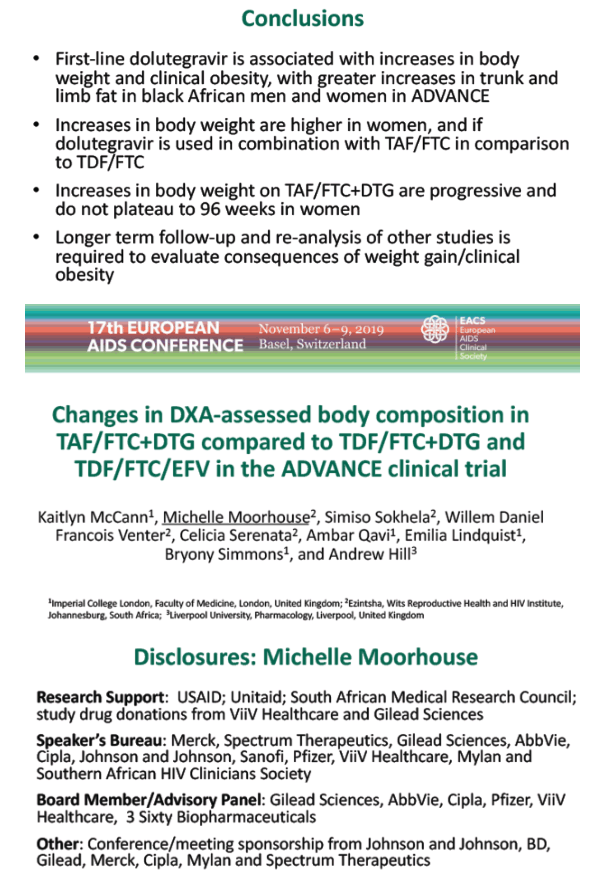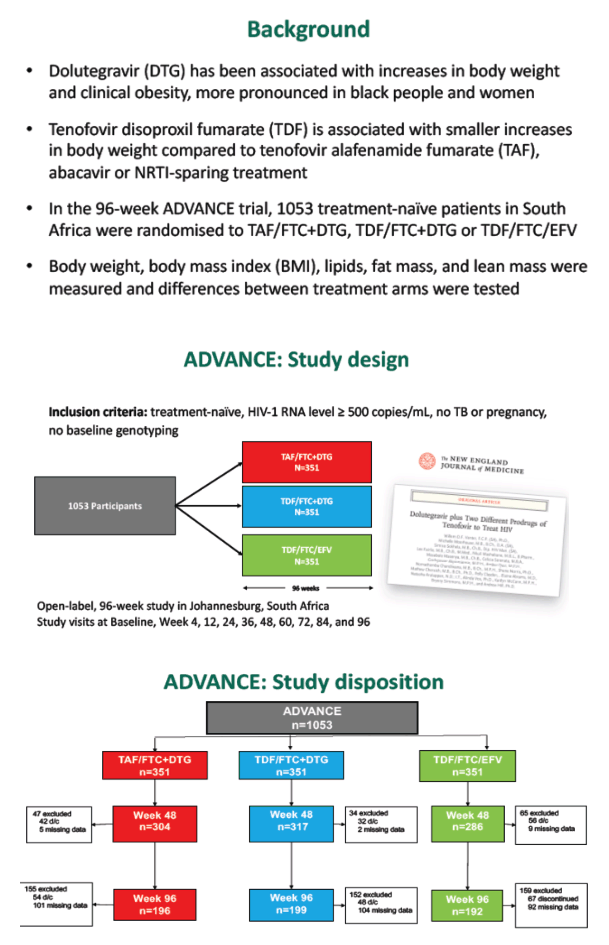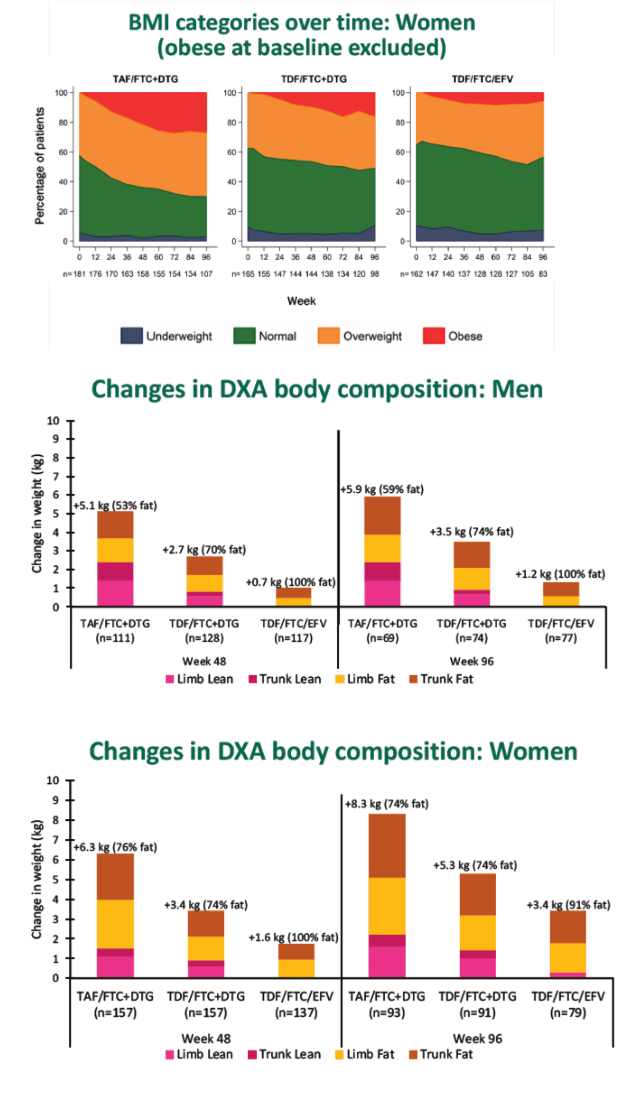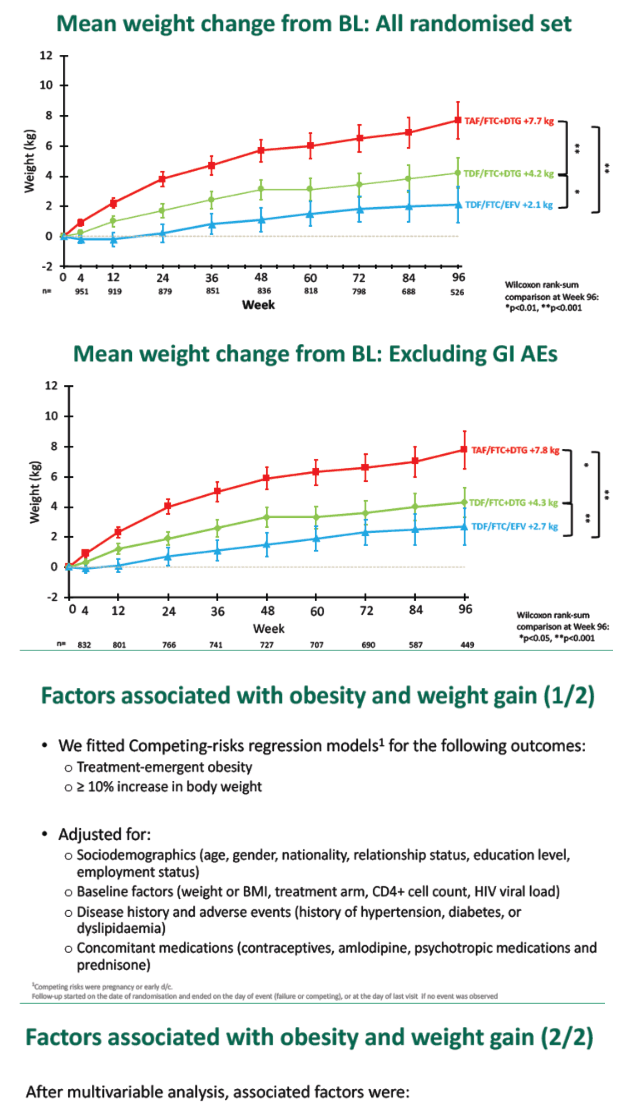 |
 |
 |
| |
The ADVANCE clinical trial: changes from baseline to week 96 in DXA-assessed body composition in TAF/FTC+DTG compared to TDF/FTC+DTG, and TDF/FTC/EFV
Weight Keeps Rising Through 96 Weeks With TAF/FTC+DTG in Black Africans
|
| |
| |
17th European AIDS Conference, November 6-9, 2019, Basel
Mark Mascolini
Through week 96 of the ADVANCE trial, weight and obesity rates continued to increase with first-line dolutegravir (DTG) in black South African women and men [1]. Weight gains were greatest and did not plateau through 96 weeks with DTG plus tenofovir alafenamide (TAF) and emtricitabine (FTC). ADVANCE investigators also found more treatment-emergent metabolic syndrome with TAF/FTC+DTG than with tenofovir disoproxil fumarate (TDF)/FTC+DTG, a worrisome finding since metabolic syndrome can herald diabetes and atherosclerosis.
Recent work links the integrase inhibitor DTG to weight gains, especially in blacks and women. Gains have proved greater with regimens containing TAF than TDF. Thus results of ADVANCE merit close attention because the trial takes place in South Africa and involves a high proportion of women.
ADVANCE recruited 1053 antiretroviral-naive nonpregnant adults without TB and randomized them equally to TAF/FTC+DTG, TDF/FTC+DTG, or TDF/FTC/efavirenz (EFV). Participants were at least 12 years old. This open-label study took place in Johannesburg, and week-48 results have been published [2]. Week-96 data involved 196 people randomized to TAF/FTC+DTG, 199 randomized to TDF/FTC+DTG, and 192 randomized to TDF/FTC+EFV. Across those three groups, 61%, 59%, and 57% were women, virtually 100% were black, and age averaged 33, 32, and 32. Pretreatment CD4 count averaged 349, 323, and 337.
When the trial began, average body mass index in women in all three study arms stood just above the threshold to overweight (25 kg/m2). Pretreatment proportions of overweight women and men (25 to 30 kg/m2) were 27% on TAF/FTC+DTG, 22% on TDF/FTC+DTG, and 22% on TDF/FTC+EFV. Proportions of obese people in those three groups were 10%, 14%, and 13%.
Through 96 weeks among men, weight gains averaged 6 kg with TAF/FTC+DTG, 3 kg with TDF/FTC+DTG, and 1 kg with TDF/FTC+EFV. Through 96 weeks among women, weight gains averaged 9 kg with TAF/FTC+DTG, 5 kg with TDF/FTC+DTG, and 3 kg with TDF/FTC+EFV. Among both men and women taking TAF/FTC+DTG, weight gains had not seemed to flatten out by week 96. At that point about 60% of women taking TAF/FTC+DTG gained at least 10% in weight, compared with about 30% of women in the other two study arms. By week 96 about 70% of women taking TAF/FTC+DTG were overweight or obese, compared with about 50% in the other two arms.
Among all randomized participants, 96-week weight gain averaged 7.7 kg in the TAF/FTC+DTG group, a significantly greater gain than in the TDF/FTC+DTG group (4.2 kg) or the TDF/FTC+EFV group (2.1 kg) (P < 0.001 for both comparisons). People randomized to TDF/FTC+DTG gained significantly more weight through 96 weeks than people randomized to TDF/FTC+EFV (P < 0.01).
It seemed possible that weight rose more with TAF/FTC+DTG than the other regimens because people tolerated that combination best, felt well, and ate more. So the researchers repeated the 96-week weight-gain analysis after eliminating participants with gastrointestinal adverse events. Results were nearly identical to those of the overall analysis.
Among women obesity developed by 96 weeks in 27% taking TAF/FTC+DTG, 17% taking TDF/FTC+DTG, and 11% taking TDF/FTC+EFV. Respective proportions of men who became obese through 96 weeks were 7%, 3%, and 2%. For those three regimens, proportions of women who gained more than 10% in weight were 51%, 32%, and 23%, and proportions of men 42%, 27%, and 18%.
A competing-risks regression model identified several independent predictors of treatment-emergent obesity (TAF/FTC+DTG, baseline CD4 count, baseline viral load, and baseline body mass index) and a 10% or greater weight gain (TAF/FTC+DTG, baseline CD4 count, baseline viral load, baseline weight, female sex, and age).
Using the International Diabetes Federation definition of metabolic syndrome (central obesity plus any two of the following: raised triglycerides, reduced high-density lipoprotein cholesterol, raised blood pressure, and raised fasting glucose), the researchers found that 9% randomized to TAF/FTC+DTG, 5% randomized to TDF/FTC+DTG, and 3% randomized to TDF/FTC+EFV had metabolic syndrome at week 96.
ADVANCE researchers called for longer follow-up and reanalysis of other studies to ascertain clinical consequences of weight gain and obesity with current antiretroviral regimens.
References
1. McCann K, Moorhouse M, Sokhela S, et al. The ADVANCE clinical trial: changes from baseline to week 96 in DXA-assessed body composition in TAF/FTC+DTG compared to TDF/FTC+DTG, and TDF/FTC/EFV. 17th European AIDS Conference, November 6-9, 2019, Basel. Abstract 3/3.
2. Venter WDF, Moorhouse M, Sokhela S, et al. Dolutegravir plus two different prodrugs of tenofovir to treat HIV. N Engl J Med. 2019;381:803-815. https://www.nejm.org/doi/full/10.1056/NEJMoa1902824








|
| |
|
 |
 |
|
|